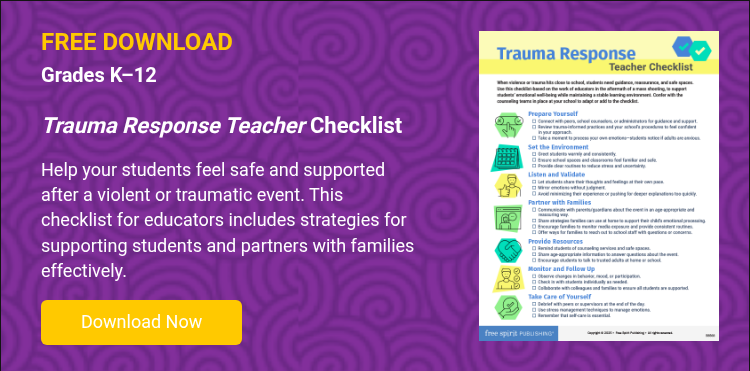When violence strikes close to home, educators play a critical role in helping students process fear and uncertainty. This personal account shows how school counselors and teachers can respond with compassion, maintain safety, and provide trauma-informed support for children facing the aftermath of local tragedies.
A City Shaken
My city of Virginia Beach, Virginia, is massive in land and population. We have wonderful diversity in this southern bubble of ours, fueled by a coast, tourist-enticing beaches, and our beloved military bases. It is both comfortably slow and expeditiously efficient. With so many people and events, we have had our fair share of complications but are statistically safe and content. No amount of sun and sand, however, could have protected our city in 2019 when we experienced violence in a way we never had before.
A few weeks before the mass shootings in El Paso and Dayton, my hometown—my place of business, the city where I raise my family—made headlines for a violent, multiple-casualty workplace event that would impact my students and community in deeply personal ways.
Understanding Mass Shootings and Trauma
Mass shootings and other large-scale traumatic events are unpredictable and abrupt, and tragically, increasingly commonplace in the U.S. Survivors and citizens from affected communities say that no amount of preparation could fully ready you for something so terrible, and the emotional impact spreads far beyond immediate victims.
When our sense of security and temperate living was rocked in 2019, educators were called on to help ease the fears of the young people in our city.
Children and Violence

Every time there is a mass shooting, students are reminded that life is fragile and that we are rarely completely safe. Gone are the days when parents may have restricted kids from watching the news. Young people now have easy access to graphic content, and they are living in a world of endless violence.
Effects of Sustained Stress on Students
Knowing what we do about how trauma and sustained stress affects children, the ramifications of this environment are profound. Perhaps we are seeing this manifest in increasing numbers of 504 plans and IEPs, especially for students with anxiety and depression. Rising numbers of self-harm and suicide attempts may also reflect students’ awareness of mortality in a violent world.
Educators on the Front Lines
While social science professionals analyze data and seek answers, educators are on the front lines, providing immediate support to overstimulated and emotionally vulnerable students and communicating and collaborating with families.
Processing Tragedy
News broke of the Virginia Beach mass shooting at the end of the day on a Friday, with details emerging throughout the weekend. My peers and I communicated constantly as the names of the victims were released and fragments of the event came to light.
Layers of Concern
There were multiple layers to consider.
- Who among our students and staff was directly affected?
- Which families and teachers had personal connections to the victims?
- How would students process the news at home?
- What resources would they need when school resumed?
Large-scale tragedies bring collective trauma, extending beyond immediate victims. When our city was touched by this violence, the fear went beyond empathy; the probability of victimhood suddenly felt real.
Responding to Violence as Educators
School counselors and educators respond to trauma every day. My approach combined three key strategies.
Reach Out
I sought resources to feel connected and gain insight into trauma-informed practices. Peers, guidance from administration, and advice from our school social worker helped me build a toolkit for this unprecedented situation. Feeling supported boosted my confidence.
Show Up
Environmental readiness mattered. Students walking into school needed to feel the same safe and positive space they had known before the tragedy. This included greeting students in the hallways, checking in with teachers, being open to conversation, and reminding students of counseling support resources.
Stand Back
I applied lessons from play therapy, allowing students to process events without pushing for deeper explanations. Students naturally reflected and expressed their feelings; my role was to mirror and validate their emotions while letting them lead conversations.
Facing the Day
On Monday, a student entered school holding the door for me. “Mrs. Filio, did you hear about what happened? My mom works in the building; she came home crying.” I paused, processing my own feelings, then asked what he felt. He admitted it was scary but that his mother was safe. I reassured him and reminded him that he could come see me anytime.
Throughout the day, similar interactions unfolded across all schools. It was emotionally exhausting, but the school counseling team demonstrated the importance of collaboration and shared responsibility.
Moving Forward as a Community
Virginia Beach taught us that when violent events touch a community, sadness blankets the city. Uncertainty dominates, yet communities move forward together. People supported each other in schools, workplaces, kitchens, and public spaces.
Lessons for Educators
Through shared resilience, educators can:
- model compassion and humanity for students
- create safe learning environments
- provide trauma-informed guidance
- foster community and connection beyond fear
Moving Forward After Violence
When violence strikes close to home, educators are uniquely positioned to provide trauma-informed support, to create safe learning environments, and to guide students in processing complex emotions. By reaching out, showing up, and letting students lead their emotional responses, schools can help children regain a sense of safety and demonstrate that community, compassion, and resilience thrive even in the aftermath of tragedy.

